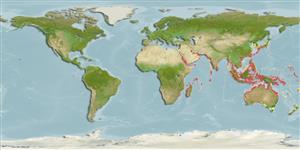Common names from other countries
Environment: milieu / climate zone / depth range / distribution range
Ekologi
marina; brackvatten; djupintervall 0 - 10 m (Ref. 86942). Tropical
Indo-West Pacific: tropical waters.
Size / Vikt / Age
Maturity: Lm ? range ? - ? cm
Max length : 61.0 cm TL hane/ej könsbestämd; (Ref. 117080); common length : 30.0 cm FL hane/ej könsbestämd; (Ref. 3287)
Taggstrålar i ryggfenan (totalt) : 9; Mjukstrålar i ryggfenan (totalt) : 23 - 27; Taggstrålar i analfenan: 3; Mjukstrålar i analfenan: 20 - 23.
Adults are common in shallow coastal waters where it often swims near the surface. They form dense schools on clear inner reefs, swimming high above substrate (Ref. 48635). They feed chiefly on shrimps, copepods, decapods and small fishes (Ref. 30573, 90102).
Life cycle and mating behavior
Maturities | Reproduktion | Spawnings | Egg(s) | Fecundities | Larver
Paxton, J.R., D.F. Hoese, G.R. Allen and J.E. Hanley, 1989. Pisces. Petromyzontidae to Carangidae. Zoological Catalogue of Australia, Vol. 7. Australian Government Publishing Service, Canberra, 665 p. (Ref. 7300)
IUCN Red List Status (Ref. 130435)
CITES (Ref. 128078)
Not Evaluated
Threat to humans
Harmless
Human uses
Fiskeri: mindre kommeriell
Verktyg
Special reports
Download XML
Internet-källor
Estimates based on models
Preferred temperature (Ref.
115969): 23.8 - 29.2, mean 28.5 (based on 2765 cells).
Phylogenetic diversity index (Ref.
82804): PD
50 = 0.5312 [Uniqueness, from 0.5 = low to 2.0 = high].
Bayesian length-weight: a=0.01148 (0.00712 - 0.01853), b=2.89 (2.76 - 3.02), in cm Total Length, based on LWR estimates for this species & (Sub)family-body (Ref.
93245).
Trofisk nivå (Ref.
69278): 3.7 ±0.55 se; based on food items.
Resiliens (Ref.
120179): Mellan, lägsta populationsfördubblingstid 1,4-4,4 år (Preliminary K or Fecundity.).
Fishing Vulnerability (Ref.
59153): Moderate vulnerability (44 of 100).
